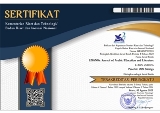Wijhāt an-Naḍar ad-Dīniyah wa aṡ-Ṡaqāfiyah fī Riwāyati “Banāt ar-Riyāḍ” li Rajaa al-Sanea: Naqd Adabī Islāmī
وجهات النظر الدينية والثقافية في رواية "بنات الرياض" لرجاء الصانع: نقد أدبي إسلامي
DOI:
https://doi.org/10.18326/lisania.v8i1.105-125Keywords:
Banāt Riyaḍ novel, Islamic literature perspective, religious superiority, Cultural viewsAbstract
This study aims to analyze the religious and cultural views of Rajaa al-Sanea in her novel Banāt Riyad from the perspective of Islamic literature. The novel has garnered both support and rejection from readers since its publication in 2005. The author portrays the characters with a lifestyle like American girls. Not only is the figure's name Westernized, but even the way of dressing and appearance is also very different from the habits of Saudi girls. However, the novelist claims that religious superiority exists in her novel. This research is qualitative. The data collection technique in this study is a documentation technique. This study uses the method of literary criticism from the perspective of Islamic Literature، which paralleles the mission of literary works and Islamic teachings. The criteria for judging and criticizing Islamic literature for works of fiction prioritize noble values and propriety, not freedom of expression. Based on this perspective، the researcher identifies deviations from Islamic teachings contained in the novel. The behavior of the novelists does not reflect the image of Islam. Harassment of religious symbols appears in the dialogue of characters who often use vulgar language. Gentle, beautiful, and polite language is not found in this novel.
References
أفيقه، إ. ن. (2018). الواقع الإجتماعي فى رواية بنات الرياض لرجاء عبد الله الصانع (دراسة تحليلية تركيبية جينيتكية). Prosiding Konferensi Nasional Bahasa Arab IV, Malang, 674–682.
الباتلي، خ. ب. ع. ا. (د.ت.). هذه حقيقة (بنات الرياض) رؤية ونقد لرواية (بنات الرياض). Retrieved 16 June 2019، from https://saaid.net/Minute/147.htm
الباشا، ع. ا. ر. (2008). نحو أدب إسلامي في الأدب والنقد. القاهرة: دار الأدب الإسلامي.
البخاري، أ. ع. م. ب. إ. (2002). صحيح البخاري (الأولى). بيروت: دار إبن كثير.
الخشب، إ. ع. أ. (1985). فى محيط النقد الأدبى. مصر: الهيئة المصرية العامة للكتاب.
الدمشقى، أ. ا. إ. ب. ع. ب. ك. ا. (2009). تفسير القرآن العظيم. ط2، الرياض: دار طيبة.
الشايب، أ. (1994). أصول النقد الأدبي. القاهرة: مكتبة النهضة المصرية.
الصانع، ر. ع. ا. (2019). بنات الرياض. Retrieved from https://www.kutub-pdf.net/book/6042-بنات-الرياض
العجيري، ع. ا. ب. ص. (د.ت.). من عبث الرواية نظرات من واقع الرواية السعودية. Retrieved from https://www.noor-book.com/en/ebook-من-عبث-الروايه-نظرات-من-واقع-الروايه-السعوديه-ل-عبد-الله-بن-صالح-العجيري--pdf
القاسم، ن. (د.ت.). رجاء الصانع ابنة الثلاث والعشرين في روايتها بنات الرياض، عرفت كيف تستفزّ وتثير وتشدّ. Retrieved 20 June 2019، from http://www.nabih-alkasem.com/rajaa_sane3.htm
الكيلاني، ن. (1987). الإسلامية والمذاهب الأدبية. بيروت: مؤسسة الرسالة.
______. (1987). مدخل إلى الأدب الإسلامي. الدوحة: مطابع الدوحة الحديثة.
______. (2015). تجربتي الذاتية في القصة الإسلامية. القاهرة: الصحوة.
النيسابوري، ا. ا. م. ب. ا. (2006). صحيح مسلم. ط1، الرياض: دار طيبة للنشر والتوزيع.
الودغيري، ص. (2017). رسالة الأدب في المنظومة الأخلاقية Retrieved 10 February 2021 from https://almoslim.net/node/278545
بريغش، م. ح. (1996). الأدب الإسلامي أصوله وسماته. بيروت: مؤسسة الرسالة.
بعلبكي، ل. (د.ت.). أنا أحيا. بيروت: دار الأدب.
حمداوي، ج. (د.ت.). النظرية الإسلامية في الأدب والنقد . Retrieved 10 May 2019، from http://www.saaid.net/feraq/mthahb/100.htm
راغب، ن. (د.ت.). المذاهب الأدبية من الكلاسيكية إلى العبثية. مصر: الهيئة المصرية العامة للكتاب.
رجاء الصانع (د.ت.). . Retrieved from https://manhom.com/شخصيات/رجاء-بنت-عبدالله-الصانع/
ريكا، أ. (2022). صورة المرأة في رواية بنات الرياض بقلم رجاء الصانع (دراسة النقد الأدبي النسوي). الجامعة كياهي الحاج أحمد صديق الإسلامية الحكومية.
سلسبيلا، ن. ا. (2022). الصراع الإجتماعي في رواية "بنات الرياض" لرجاء الصانع: دراسة أدبية إجتماعية عند إيان وات. جامعة مولانا مالك إبراهيم الإسلامية الحكومية.
سنكر، ع. ا. (2021). جدلية العلاقة بين الأدب والدِّين. Retrieved from رابطة الأدب الإسلامي العالمية website: https://www.adabislami.org/magazine/2021/11/4904/269
فريزجرار، م. (1988). خصائص القصة الإسلامية. جدة: دار المنارة.
مستغانمي، أ. (2000). ذاكرة الجسد. بيروت: دار الأدب.
موناردي، ح. (2019). العناصر الداخلية في الرواية "بنات الرياض" لرجاء الصانع (دراسة الأدبية). جامعة شريف هداية الله الإسلامية الحكومية.
ناصر، ب. ق. (د.ت.) .محاضرات في النقد الأدبي الحديث. مركز الشهيدين الصدرين للدراسات والبحوث.
Angelica, N. (2022). KRITIK NOVEL ISLAMMU ADALAH MAHARKU KARYA ARIO MUHAMMAD PENDEKATAN RELIGIUS. BASINDO : Jurnal Kajian Bahasa, Sastra Indonesia, Dan Pembelajarannya, 7(1), 126–134.
Faisol, M., & Kholil، A. (2018). Pembebasan Perempuan dalam Novel Banāt Al-Riyāḍ Karya Raja’ Abd Allāh Al-Ṣāni’. Adabiyyāt: Jurnal Bahasa Dan Sastra، 2(1,، 127–155. https://doi.org/10.14421/ajbs.2018.02106
Ibrahi, P. H., A, P.H.;, S. mail to I., Sarkawi, A. A., B, A.A.;, S. mail to S., … M.M.R., S. mail to A. (2023). Islamic Perspectives of Integrating Muslim Cemeteries Planning with Recreational Areas in Urban Setting. 2023. https://doi.org/10.24035/ijit.21.2022.231
Ichsan, H. (2021). Building Identity in Global Reality: a Postcolonial Study on Rajaa Alsanea’s Banat Ar-Riyadh. Poetika، 9(1), 23. https://doi.org/10.22146/poetika.v9i1.63956
Irawan, S. (2011). Girls of Riyadh: The Arab-American Michele`s Search for a Cultural Identity (Unika Soegiapranata, Semarang). Unika Soegiapranata, Semarang. Retrieved from http://repository.unika.ac.id/19043/6/07.80.0043 Shinta Irawan -BAB 5.pdf
Racman, S. M. H. A. (2023). Is there Sexism in Islamic Leadership ? The Case of the Sultanahs in Lanao Sultanate, Philippines. 2023. https://doi.org/10.32350/jitc.122.07
Shestopalets, D. (2021). Between faith and ethnicity: motifs of conversion and attitudes to ethnic Muslims in the discourses of Russian converts to Islam. Contemporary Islam, 15(3), 357–380. https://doi.org/10.1007/s11562-021-00474-2
Syahril. (2014). Arena Produksi Kultural dan Kekerasan Simbolik (Analisis Terhadap Novel Banât al-Riyâdh Perspektif Sosiologi Pierre Bourdieu). Jurnal Ilmiah Peuradeun, 2(1), 75–92.
Syahril. (2017). The Girls of Riyadh (Analisis Sastra Islam). Jurnal Bidayah, 8(2), 147–158.
Zhou, W. (2023). Central Hunan Lutheran Church’s Progress toward Self-Reliance (1902–1951): A Study Based on the Archives of the Norwegian Missionary Society. Religions، 14(9), 1135. https://doi.org/10.3390/rel14091135
Downloads
Published
Issue
Section
License
Copyright (c) 2024 LISANIA: Journal of Arabic Education and Literature

This work is licensed under a Creative Commons Attribution-NonCommercial-ShareAlike 4.0 International License.






